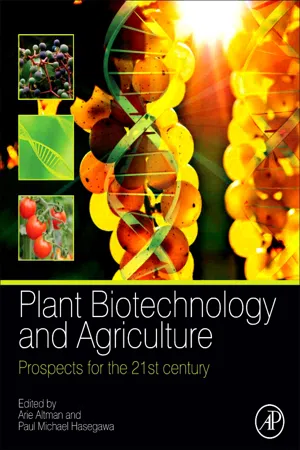
Plant Biotechnology and Agriculture
Prospects for the 21st Century
- 624 pages
- English
- ePUB (mobile friendly)
- Available on iOS & Android
About this book
As the oldest and largest human intervention in nature, the science of agriculture is one of the most intensely studied practices. From manipulation of plant gene structure to the use of plants for bioenergy, biotechnology interventions in plant and agricultural science have been rapidly developing over the past ten years with immense forward leaps on an annual basis.This book begins by laying the foundations for plant biotechnology by outlining the biological aspects including gene structure and expression, and the basic procedures in plant biotechnology of genomics, metabolomics, transcriptomics and proteomics. It then focuses on a discussion of the impacts of biotechnology on plant breeding technologies and germplasm sustainability. The role of biotechnology in the improvement of agricultural traits, production of industrial products and pharmaceuticals as well as biomaterials and biomass provide a historical perspective and a look to the future. Sections addressing intellectual property rights and sociological and food safety issues round out the holistic discussion of this important topic.- Includes specific emphasis on the inter-relationships between basic plant biotechnologies and applied agricultural applications, and the way they contribute to each other- Provides an updated review of the major plant biotechnology procedures and techniques, their impact on novel agricultural development and crop plant improvement- Takes a broad view of the topic with discussions of practices in many countries
Frequently asked questions
- Essential is ideal for learners and professionals who enjoy exploring a wide range of subjects. Access the Essential Library with 800,000+ trusted titles and best-sellers across business, personal growth, and the humanities. Includes unlimited reading time and Standard Read Aloud voice.
- Complete: Perfect for advanced learners and researchers needing full, unrestricted access. Unlock 1.4M+ books across hundreds of subjects, including academic and specialized titles. The Complete Plan also includes advanced features like Premium Read Aloud and Research Assistant.
Please note we cannot support devices running on iOS 13 and Android 7 or earlier. Learn more about using the app.
Information
J.S. (Pat) Heslop-Harrison and Trude Schwarzacher
Table of Contents
Plants and Domestication
Scope
Domesticated crops
Table of contents
- Cover image
- Table of Contents
- Front-matter
- Copyright
- Dedication
- Contributors
- Foreword
- Preface
- Introduction to plant biotechnology 2011: Basic aspects and agricultural implications
- 1. Genetics and genomics of crop domestication
- 2. The scope of things to come
- 3. Protein targeting
- 4. Proteomics and its application in plant biotechnology
- 5. Plant metabolomics
- 6. Plant genome sequencing
- 7. Agrobacterium-mediated plant genetic transformation
- 8. Biolistic and other non-Agrobacterium technologies of plant transformation
- 9. Plant tissue culture for biotechnology
- 10. Somatic (asexual) procedures (haploids, protoplasts, cell selection) and their applications
- 11. Marker-assisted selection in plant breeding
- 12. Male sterility and hybrid seed production
- 13. Advances in identifying and exploiting natural genetic variation
- 14. From epigenetics to epigenomics and their implications in plant breeding
- 15. An engineering view to micropropagation and generation of true to type and pathogen-free plants
- 16. Regulation of apomixis
- 17. Germplasm collection, storage, and conservation
- 18. Integrating genomics and genetics to accelerate development of drought and salinity tolerant crops
- 19. Molecular responses to extreme temperatures
- 20. Biotechnological approaches for phytoremediation
- 21. Biotechnological strategies for engineering plants with durable resistance to fungal and bacterial pathogens
- 22. Controlling plant response to the environment
- 23. Insects, nematodes, and other pests
- 24. Growth control of root architecture
- 25. Control of flowering
- 26. Fruit development and ripening
- 27. Potential application of biotechnology to maintain fresh produce postharvest quality and reduce losses during storage
- 28. Engineering the biosynthesis of low molecular weight metabolites for quality traits (essential nutrients, health-promoting phytochemicals, volatiles, and aroma compounds)
- 29. Vaccines, antibodies, and pharmaceutical proteins
- 30. Plants as factories for bioplastics and other novel biomaterials
- 31. Bioenergy from plants and plant residues
- 32. Containing and mitigating transgene flow from crops to weeds, to wild species, and to crops
- 33. Intellectual property rights of biotechnologically improved plants
- 34. Regulatory issues of biotechnologically improved plants
- 35. Prospects for increased food production and poverty alleviation
- 36. Crop biotechnology in developing countries
- Index